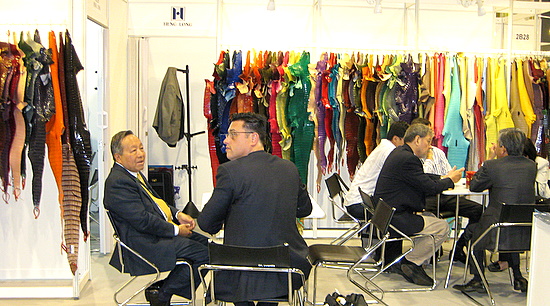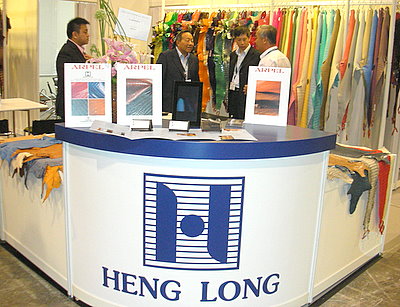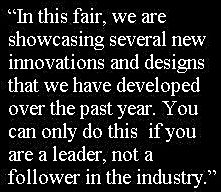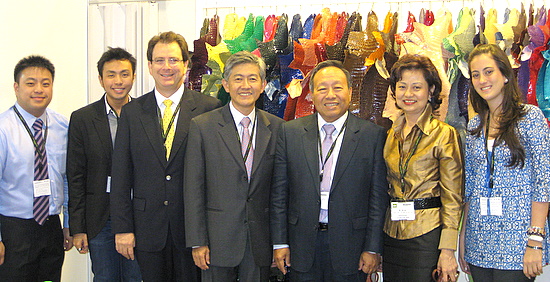

THE ITALIANS were exhibitors at the event for the first time. And what a sizeable group they were. Their pavilion was certainly conspicuous too, as it was sprawled across 200 sq m.
I was at the annual Asia Pacific Leather Fair – Materials, Manufacturing & Technology 2009 which was held at Hong Kong Convention and Exhibition Centre recently.
There were 20 other pavilions from Singapore, Australia, Brazil, China, Egypt, Ethiopia, France, Germany, India, italy, Korea, Mexico, New Zealand, Pakistan, Spain, Taiwan, Thailand, Turkey, UK and USA.
I made my way to the SGX-listed Heng Long International Limited’s booth.
Heng Long is one of the 5 top-tier tanneries of crocodile leather in the world, specialising in the supply of high-quality crocodilian leather used by customers in the luxury and high-end fashion industry.
The Company’s main activities include sourcing, tanning and processing of a wide range of raw crocodile skins into crusts and high-quality premium finished crocodilian leathers.
Its customers, whom typically are product manufacturers of the luxury and high-end fashion brands, will eventually develop them into handbags, watchstraps, garments, shoes, boots and other accessories.
“We are experiencing fairly similar traffic volume as last year. In fact, there are more enquiries. Whether these enquiries translate into physical orders, we have to wait and evaluate the situation a few weeks later,” Mr. CT Koh, the Group Managing Director said after I enquired about the visitor response.
Due to its enduring appeal, crocodilian leather has always been in high demand from consumers, hence the luxury and fashion houses, and a staple product for each fashion season. This trend will overall be positive for Heng Long, added Mr Koh. 
Crocodile leather vs ostrich leather
Heng Long sells a year-old alligator skin typically at US$160-180, while a 3-year old alligator skin, up to US$600.
Higher-grade skins can command a price about 20-30% higher.
I got to know Mr Warren Liu, Technical Manager, who has over 30 years of experience in leather chemicals and technology. At Heng Long, he is responsible for the R&D including product development, monitoring the technical quality of its products and providing technical advice and support to customers.
I asked him about the barriers to entry in this trade. “Crocodilian skin is a niche market. This is not a business that you can penetrate overnight even if you have the capital. This trade is highly regulated by CITES (Convention on International Trade in Endangered Species of Wild Fauna and Flora). You also need time to build up trust with the luxury fashion buyers as well as the crocodile farmers. Hence, I believe the high barriers to entry will deter potential competition,” he said.
“In this fair, we are showcasing several new innovations and designs that we have developed over the past year. You can only do this, if you are a leader, not a follower in the industry.”
Walking around the exhibition hall, I saw several booths which were displaying ostrich leather. Piqued, I asked Mr CH Koh, Heng Long's Executive Director, how ostriches fared against crocodiles in this business.
He replied: “Ostrich skin and leather have long been perceived as low-value due to intense competition in the ostrich-skin trade arising from lower capital requirements. As a result of the widespread usage of ostrich leather, coupled by the ready availability of supply, it has gradually lost its exclusivity and exotic value.
"Even though some fashion houses still use it for high-end products like jackets and handbags, we don’t see this market growing fast.”
Is Heng Long experiencing a pick-up in demand from China?
Typically, its biggest customers are from Europe: The Novalpina Group, which supplies to luxury brands owned by the Richemont Group; Swatch Group; Rolex and Franck Muller; as well as the Ally Project SRL, which supplies to Prada; Stefano Ricci; Testoni; Zagliani and Brioni.
”Whilst Europe will remain as our major markets, we believe countries like China would be an important growth engine for us in the coming years.
“For China, we are seeing a gradual pick-up as more PRC companies turn to crocodile leather for their products. We are working with the local authority to explore how we can make the import and export of crocodile skins a lot easier and efficient for these companies,” Mr CH Koh added.
How about Europe?
“The upcoming Lineapelle leather fair in April in Bologna, Italy, is the most important international leather show for us - we can interact with our European customers and get a good feel of the market for the year ahead,” chipped in Mr Albert Koh, production co-ordinator of Heng Long and a son of Mr CT Koh.
Recent story: HENG LONG: Targeting China







